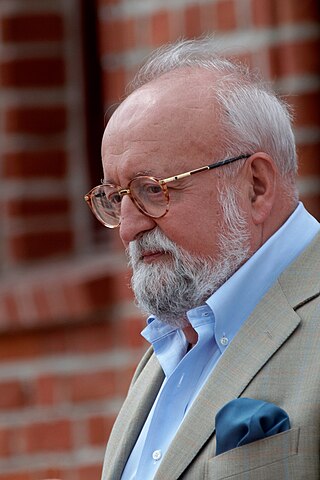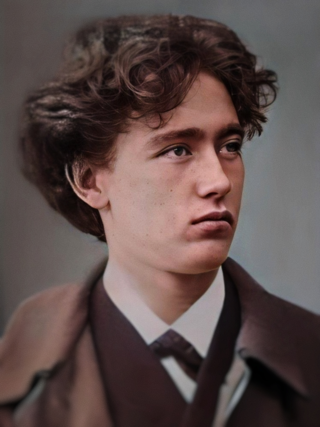
The Symphony No. 1 in E minor, Op. 39, is a four-movement work for orchestra written from 1898 to 1899 by the Finnish composer Jean Sibelius.
The Young Person's Guide to the Orchestra, Op. 34, is a 1945 musical composition by Benjamin Britten with a subtitle Variations and Fugue on a Theme of Purcell. It was based on the second movement, "Rondeau", of the Abdelazer suite. It was originally commissioned for the British educational documentary film called Instruments of the Orchestra released on 29 November 1946, directed by Muir Mathieson and featuring the London Symphony Orchestra conducted by Malcolm Sargent; Sargent also conducted the concert première on 15 October 1946 with the Liverpool Philharmonic in the Philharmonic Hall, Liverpool, England.
Polish composer Witold Lutosławski's Concerto for Orchestra was written in the years 1950–54, on the initiative of the artistic director of the Warsaw Philharmonic, Witold Rowicki, to whom it is dedicated. It is written in three movements, lasts about 30 minutes, and constitutes the last stage and a crowning achievement of the folkloristic style in Lutosławski's work. That style, inspired by the music of the Kurpie region, went back in time to the pre-1939 years. Having written a series of small folkloristic pieces for various instruments and their combinations, Lutosławski decided to use his experience of stylisation of Polish folklore in a bigger work. However, the Concerto for Orchestra differs from Lutosławski's earlier folkloristic pieces not only in that it is more extended, but also in that what is retained from folklore is only melodic themes. The composer moulds them into a different reality, lending them new harmony, adding atonal counterpoints, and turning them into neo-baroque forms.

The Symphony No. 5 in E-flat major, Op. 82, is a three-movement work for orchestra written from 1914 to 1915 by the Finnish composer Jean Sibelius. He revised it in 1916 and again from 1917 to 1919, at which point it reached its final form.
The Symphony No. 5 in B-flat major, Op. 55, was written by Alexander Glazunov from April to October 1895. Although in this symphony Glazunov returned to his conventional four-movement layout he frequently utilizes thematic transformation.
The Symphony No. 2 in E minor and C major by Arnold Bax was completed in 1926, after he had worked on it for two years. It was dedicated to Serge Koussevitzky, who conducted the first two performances of the work on 13 and 14 December 1929.
The Symphony No. 3 by Arnold Bax was completed in 1929. It was dedicated to Sir Henry Wood and is perhaps the most performed and most immediately approachable of Bax's symphonies.
The Symphony No. 1 by Arnold Bax was completed in 1922 and dedicated to John Ireland. Its outer movements were based on a Piano Sonata in E♭ that Bax subsequently orchestrated, while the central movement was newly composed for the symphony.
The Symphony No. 4 by Arnold Bax was completed in 1930 and dedicated to Paul Corder. It was inspired by Bax's love of the sea and premiered in 1931 by British conductor Basil Cameron and the San Francisco Symphony Orchestra.
The Symphony No. 5 by Arnold Bax was completed in 1932 and dedicated to Jean Sibelius. It is in many ways heavily influenced by Sibelius.
Symphony No. 7 by Arnold Bax was completed in 1939 and dedicated to "The People of America". The work received its first performance in Carnegie Hall, New York City, by the New York Philharmonic on 10 June 1939 under the baton of Sir Adrian Boult. It was commissioned by the British Council to be played at the 1939 New York World's Fair, along with Arthur Bliss's Piano Concerto in B-flat, and Ralph Vaughan Williams' Five Variants of Dives and Lazarus.
November Woods is a tone poem by Arnold Bax, written in 1917. Ostensibly a musical depiction of nature, the work conveys something of the composer's turbulent emotional state arising from the disintegration of his marriage and his love affair with the pianist Harriet Cohen. According to the composer, the piece is not programmatic, but evokes mood rather than painting a picture or telling a story.
The Symphony in F-sharp, Op. 40, is the only symphony by 20th-century Austrian composer Erich Wolfgang Korngold, although as a teenager in 1912 he had written a Sinfonietta, his Op. 5. Using a theme from the 1939 film The Private Lives of Elizabeth and Essex, the symphony was completed in 1952 and dedicated to the memory of American president Franklin D. Roosevelt, who had died seven years earlier.
Pyotr Ilyich Tchaikovsky composed his Orchestral Suite No. 3 in G, Op. 55 in 1884, writing it concurrently with his Concert Fantasia in G, Op. 56, for piano and orchestra. The originally intended opening movement of the suite, Contrastes, instead became the closing movement of the fantasia. Both works were also intended initially as more mainstream compositions than they became; the fantasia was intended as a piano concerto, while the suite was conceived as a symphony.

The Symphony No. 3 is a symphony in five movements composed between 1988 and 1995 by Krzysztof Penderecki. It was commissioned and completed for the centenary of the Munich Philharmonic. Its earliest version, Passacaglia and Rondo, premiered at the International Music Festival Week in Lucerne, Switzerland, on August 20, 1988. It was performed by the Lucerne Festival Orchestra and conducted by Penderecki. The full symphony premiered in Munich on 8 December 1995, performed by the Munich Philharmonic, again conducted by the composer.
The Symphony No. 1 by the British composer Michael Tippett was completed in 1945.

Symphony No. 3 is a composition by the Brazilian composer Heitor Villa-Lobos, written in 1919. A performance lasts about 35 minutes.
Russian composer Alfred Schnittke's Symphony No. 8 was composed in 1994. Its dedicatee Gennady Rozhdestvensky conducted the Royal Stockholm Philharmonic Orchestra in the symphony's premiere in Stockholm on 10 November 1994.

The Symphony No. 1 in G minor by Russian composer Vasily Kalinnikov was written from 1894 to 1895 and first published in 1900. The symphony is dedicated to Russian music critic and teacher Semyon Kruglikov.

Felix Weingartner's Symphony No. 2 in E-flat major, Op. 29 is a musical composition that Weingartner started in 1897 and completed in 1899. The overall musical language of the piece is late-romantic although with a high emphasis on Schubertian melodicism. Furthermore, as with other contemporary Austrian composers of the end of the 20th century such as Gustav Mahler or Hans Rott, his second symphony heavily uses a Brucknerian treatment of simple motifs through extensive repetition and grand orchestration.





